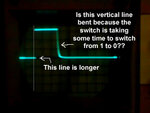- Joined
- Jul 4, 2009
- Messages
- 16,230
- Helped
- 5,140
- Reputation
- 10,309
- Reaction score
- 5,118
- Trophy points
- 1,393
- Location
- Aberdyfi, West Wales, UK
- Activity points
- 137,351
I suspect there is another fault.
Firstly, the spikes indicate excessive high frequency response and your home made probe has the opposite effect of reducing high frequencies passing through it. Wait until you new probe arrives or you may be hiding the fault you are trying to fix.
Regardless of the probe quality, you should see the size of the waveform change as you turn the Y attenuator (volts/div) control. If it doesn't change there is probably a fault in the input amplifier and it could also be responsible for the signal overshoot. The trouble with this kind of fault is you need a second oscilloscope to follow the signal in the first one!
Try these two tests and tell me the results.:
1. Can you confirm the displayed waveform is still very small if you use a short wire to directly link the calibrator output to the center pin of the input socket.
2. If you set the switch to GND the waveform should disappear, leaving just a straight line. Set the Y position so the trace follows the black line across the middle of the screen. Now in the DC position, the square wave should sit on top of the black line, in the AC position it should be sitting half above and half below. Let me know if this is what you see.
Brian.
Firstly, the spikes indicate excessive high frequency response and your home made probe has the opposite effect of reducing high frequencies passing through it. Wait until you new probe arrives or you may be hiding the fault you are trying to fix.
Regardless of the probe quality, you should see the size of the waveform change as you turn the Y attenuator (volts/div) control. If it doesn't change there is probably a fault in the input amplifier and it could also be responsible for the signal overshoot. The trouble with this kind of fault is you need a second oscilloscope to follow the signal in the first one!
Try these two tests and tell me the results.:
1. Can you confirm the displayed waveform is still very small if you use a short wire to directly link the calibrator output to the center pin of the input socket.
2. If you set the switch to GND the waveform should disappear, leaving just a straight line. Set the Y position so the trace follows the black line across the middle of the screen. Now in the DC position, the square wave should sit on top of the black line, in the AC position it should be sitting half above and half below. Let me know if this is what you see.
Brian.
